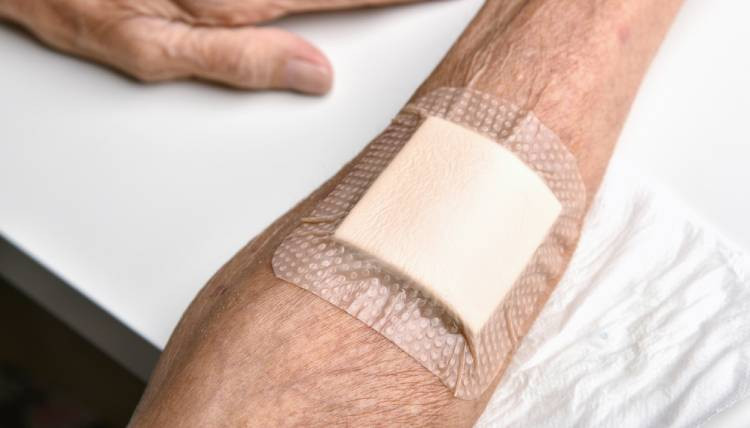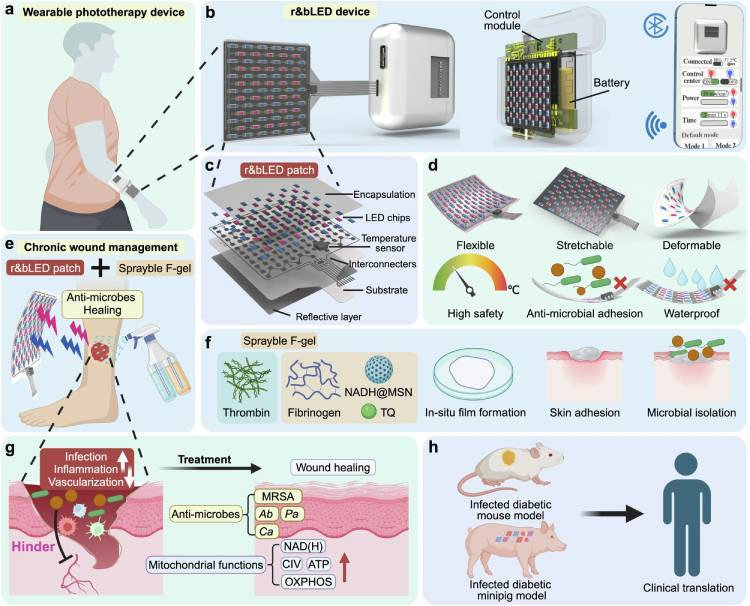Stretchy LED Device for Home Wound Healing and Infection Care
Technical Analysis | 05-12-2024 | By Liam Critchley

Many parts of the world have a large ageing population, and when coupled with disease and non-healing chronic wounds, many health systems and economies are under threat due to the level of regular care that is required.
While chronic wounds might not sound as serious as some other ailments, the frequency at which they open can provide a naturally favourable and fertile environment for pathogenic microorganisms. Microbes in wound sites can interfere with the body’s natural wound-healing processes, leading to inflammation, delayed healing, and infections that, if left untreated, can lead to amputation and even death in some cases.
Key Things to Know:
- Chronic wounds are a growing challenge worldwide, especially in ageing populations and among those with underlying health conditions like diabetes.
- Untreated or poorly managed chronic wounds can lead to severe complications, including infections, amputations, and even death.
- Antibiotic resistance is limiting the effectiveness of traditional treatments, creating an urgent need for alternative therapies.
- Photodynamic therapy (PDT) is a non-invasive, light-based treatment that offers dual benefits: accelerating wound healing and controlling infections.
- Current PDT systems are primarily hospital-based and bulky, highlighting the need for portable, home-use devices for chronic wound care.
The natural pharmaceutical route over the years has been antibiotics. However, many microbes are now becoming resistant to pharmaceutical therapies, so these treatments are becoming less effective. When managing chronic wounds, therapies need to target both the infection and the wound healing aspects, and an alternative to antibiotics that has emerged is to use photodynamic therapy (PDT)—a non-invasive technique which uses light and a photosensitising drug to treat the wound (and other conditions).
PDT has shown that it can promote wound healing and protect the wound against infection. However, many of the PDT devices created to date are bulky systems that are only usable inside a hospital. For patients who have chronic wound needs, having the ability to undergo home treatment where they don’t need to come into the hospital every time a wound opens up would not only save them time but give them peace of mind that they have therapy on hand, but it would also put less strain on hospitals and the wider healthcare system.
Developing a wound-healing PDT that can be used in the home has not been an easy task, but researchers have now developed a new wearable red and blue LED (r&bLED) patch that can be controlled remotely to allow treatment to take place at home.
Flexible LED Phototherapy Devices Gaining Interest
The development of flexible, wearable and conformable electronic devices has grown exponentially in recent years, with applications in the healthcare sector and beyond—often for some form of remote monitoring application. The key to wearable devices is that the active materials that make up the electronics are incredibly thin, so they can flex and bend with the flexible substrate (often a polymer) that they’re integrated into.
Notably, the use of quantum dot light-emitting diodes (QD-LEDs) and micro-LEDs has opened avenues for next-generation wearable phototherapy devices. These technologies provide high luminous efficiency and wavelength tunability, essential for optimising therapeutic effects. However, challenges such as cost and regulatory approval remain significant barriers to their widespread adoption.
Material Innovations: Stretchability and Comfort
Recent advancements in wearable technology have seen the development of materials with improved stretchability and durability, such as thermoplastic polyurethane (TPU), which can seamlessly integrate into flexible devices. TPU not only provides the mechanical strength necessary for wearable devices but also enhances user comfort by conforming to the body’s contours. Its use in flexible phototherapy devices ensures improved longevity and usability, especially in healthcare applications.
Furthermore, the integration of silver nanowire-based interconnects has revolutionised flexible LED devices by offering superior conductivity and resilience under repeated bending and stretching. This advancement facilitates the development of devices capable of maintaining consistent performance even in challenging usage scenarios, such as wound care applications requiring frequent repositioning.
Challenges in Photodynamic Therapy Applications
For PDT applications, LED light technology has also developed rapidly, but the use of flexible LED phototherapy devices for home use has had its challenges despite there being widespread interest. Micro-LEDs and organic LEDs (OLEDs) have gathered a lot of interest as a light source for flexible PDT devices. However, these have their own challenges. For example, micro-LEDs are not regulatory-approved for healthcare applications, so they are not an option for now. OLEDs are an established technology, but achieving a stable blue emission is a challenge.
Overcoming the limitations of blue OLED stability, researchers are exploring novel material formulations that enhance lifespan and efficiency. These advancements, once refined, could provide a viable alternative to traditional LEDs in flexible phototherapy devices, especially for applications requiring precise blue light emission.
Traditional LEDs: Current Best Option for PDT Devices
As it stands, traditional LEDs are the best option for wearable PDT devices, as they are already regulatory approved in the US by the FDA for medical devices and have already been shown to be safe in both clinical and home settings. They are also known for having a long lifespan, high stability and excellent monochromaticity. However, attempts to date to make wearable PDT devices have fallen a bit short. Devices with traditional LEDs for wound healing have managed to use red light effectively for wound healing. However, it has been difficult for the devices to emit blue light, so PDT wound patches have not been able to address the infection issue to date.
To better understand the advancements in wearable photodynamic therapy (PDT) devices, the diagram below showcases the structure and operation of a novel dual-wavelength red and blue LED (r&bLED) patch. This device integrates flexible and stretchable materials, enabling precise light delivery for wound healing and infection control. Its intelligent control system and compatibility with F-gel make it a transformative solution for at-home treatment of chronic wounds.

a The application overview of the wearable phototherapy device. b Diagram illustrating the structure of the wearable r&bLED patch and its control module. c Detailed breakdown of the r&bLED patch's multilayer configuration. d Key features and properties of the r&bLED patch. e Illustration of the combined treatment strategy for managing chronic wounds. f Composition and detailed analysis of the F-gel. g Assessment of the combined treatment's effectiveness. h Validation of the device's efficacy in diabetic wound healing using in vivo models, including infected diabetic mice and minipigs. This figure was created with BioRender.com and is shared under a Creative Commons Attribution-NonCommercial-NoDerivs 4.0 International license.
Biocompatible Encapsulation for Improved Safety
The inclusion of biocompatible encapsulation layers in LED devices has addressed previous concerns about skin irritation and microbial contamination. These layers, often composed of materials like polydimethylsiloxane (PDMS), ensure that the device remains safe for prolonged use, making them particularly suitable for at-home care of chronic wounds.
A breakthrough study has highlighted the use of dual-wavelength LED patches, combining red and blue light to address the dual challenges of wound healing and infection control. The red light promotes mitochondrial function to expedite tissue repair, while the blue light effectively targets and eliminates microbial biofilms. This combination represents a significant advancement in the field of photodynamic therapy, enabling comprehensive wound care in a single device.
New Stretchable Red and Blue LED Device for Wearable PDT In the Home
To address the shortcomings of flexible PDT patches to date, researchers have now developed a wearable PDT device that consists of a dual-wavelength red and blue LED (r&bLED) patch with an intelligent control module. The device has the necessary power density for a home use device, can provide stable treatments, and is stretchy enough to provide wide coverage of treatment around the wearer from the comfort of their own home. The control module (a small remote box the size of an AirPods box) allows users to easily control the wound patch in their own homes with just their mobile phones.
Layered Construction for Optimal Performance
There are multiple fabrication layers to the patch, including substrate, reflective, and PDMS encapsulation layers, interconnects, a temperature sensor and r&bLED chips. The whole device was designed to conform to the contours of the wearer to provide a uniform delivery of light, while the integrated temperature sensor ensures that the local area doesn’t get too hot as to avoid thermal skin damage during the therapy. The device was also designed to have an anti-microbial adhesion layer and be waterproof to ensure that it can be used for long time periods.
F-Gel Integration for Enhanced Therapy
The patch used alongside a sprayable fibrin gel (known as an F-gel) that contained a blue light-sensitive thymoquinone (TQ) and red light synergistic reduced nicotinamide adenine dinucleotide (NADH). The F-gel was added to the skin of the patient prior to treatment to form a thin film on the surface of the wound. When the F-gel was spread onto the skin and illuminated with the r&bLED patch, it provided both anti-infection and wound healing functions to the wound, with only a short illumination time.
During the therapy, the blue LED light killed microbes and removed the biofilms on the wound through the generation of radical oxygen species (ROS)—including antibiotic resistant microbes such as the multi-drug-resistant MRSA microbe—while the red LED light synergistically improved mitochondrial function to promote wound healing and reduce inflammation in the wound. The presence of NADH in the F-gel reduced the potential damage that could be caused by generating ROS at the wound site.
Combining the ability to create red and blue light in a single flexible wound patch, alongside the use of a functional therapy gel, has shown that it could be possible in the future to provide a lot more patients with in-home care—even with chronic conditions. An approach like the one in this study could help not only make patients more comfortable during their times of discomfort but also help ease the financial and time burden that many healthcare systems are experiencing worldwide with an ever-growing population and an ever-growing ageing population.
Conclusion
Chronic wounds present a significant challenge for healthcare systems globally, particularly in ageing populations and those with underlying conditions such as diabetes. Traditional antibiotic therapies are becoming less effective due to increasing resistance, underscoring the urgent need for innovative solutions. Photodynamic therapy (PDT) offers a promising alternative, combining infection control with enhanced wound healing through light-based treatments.
Recent advancements, such as dual-wavelength red and blue LED patches integrated with functional gels like F-gel, mark a significant step forward. These innovations address both the infection and healing aspects of chronic wounds while being designed for home use, providing patients with greater convenience and reducing the burden on healthcare systems. The integration of biocompatible materials, stretchable designs, and intelligent control modules has paved the way for safe, effective, and portable PDT solutions.
Wearable PDT devices offer a practical approach to improving chronic wound care. These technologies not only enhance patient outcomes but also demonstrate the power of innovation in addressing complex healthcare challenges. With further development and adoption, such devices could significantly improve the quality of life for patients and alleviate strain on medical infrastructure worldwide.
Reference:

